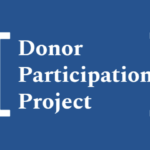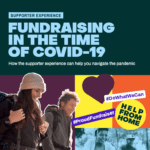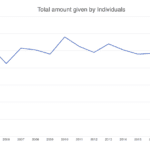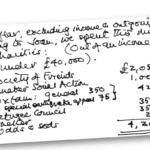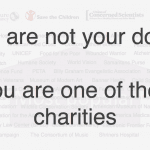When to choose choice
Choice is becoming a buzzword in fundraising. But just how important is it?
Over the last few years, organisations like Kiva, DonorsChoose and CRUK (with MyProjects) have done rather well by offering people a chance to decide how their donations are used. Kiva, which launched in 2005, has generated over $200 million for people working their way out of poverty. DonorsChoose, which is only two years older, has generated over $77 million for schools in need of teaching materials. And CRUK has over 400 individual fund raising pages and 23 project pages which have raised hundreds of thousands of pounds.
But is choice the key factor that lies behind this level of fundraising success?
There are a number of charities that have built websites around the offer of choice who haven't been quite so successful.
Take FORGE for instance. I wrote a piece about this charity back in 2008 on how they came unstuck when they focused on offering online donor choice as a means to raise funds.
See The Difference, who do some great social networking activity to promote their site, also seem to be struggling (see this post for more thoughts on their approach to fundraising). If you look at their most funded projects on their website, few have generated more than a thousand pounds.
And My Action For Children which generated a massive amount of hits from press advertising and celebrity tweets seems to have converted just a tiny percentage to donors. Sign-ups just one month later have dwindled to a trickle.
I believe the different levels of success seen by the two sets of examples is down to something other than choice.
Kiva is fundamentally different. It asks people to lend – not give. And though a supporting donation is suggested (to fund the work of the KIva organisation) this is discretionary. In effect, you are not giving to charity as you can get your money back. As we've seen in the UK with Lend With Care, this is an offer that people find different and attractive. Add feedback on the impact of your loan and fantastic celebrity and corporate support (most notably that offered by YouTube) and you have a financial success on your hands.
DonorsChoose has also benefitted from celebrity support. But at its heart it offers something very special – great feedback. Though they will accept any size of gift, DonorsChoose prompts donors to give $100 by promising them a feedback pack from the school they help. This pack contains a letter from a teacher along with drawings, thank you notes and photographs from the children who've benefitted from the donor's gift. DonorsChoose encourage schools to get really creative with these packs and see them as so important that if a school fails to provide them to donors they can be excluded from the site. The other stroke of genius of the DonorsChoose model is that they also offer a thank you pack to everyone who gives a closing gift. So if a project has just a few dollars needed to hit target, the donor who makes up the shortfall – even if it really is just ten or twenty dollars – gets a thank you pack as well.
Take a look at CRUK's MyProjects and you see two main types of donation – gifts in memory and gifts in response to personal fundraising pages. In this respect it is not that dissimilar to JustGiving. The most successful of the projects on MyProjects is the Santander staff fundraiser for mobile cancer awareness units. Santander staff have been encouraged to raise money for CRUK with the promise that if they hit a certain target they will be eligible for a trip to Brazil to help renovate a school. MyProjects has simply functioned as an online means for them to run personal fundraising activities (see what I mean about it being just like JustGiving?).
If choice was that important to donors, thousands of tiny niche charities would be doing much better. If someone wanted to offer support for disabled children in London for instance, all they need to do is type those words into Google and they'd be presented with a long list of organisations that would love a donation. And more to the point, they would probably all offer a more rewarding and personal experience of giving than can be had when you donate to the national charities you'd find bidding on those search terms through AdWords.
And here's another example of why I think that choice is only a small part of the route to better fundraising.
I started out my fundraising career at ActionAid (about twenty years ago) where I worked on a product called ProjectAid.
ActionAid raised most of its income through child sponsorship. Supporter feedback and research told us that people loved knowing how their money changed a child's life. It also told us that some people found sponsorship expensive and others found it 'emotionally unattractive'.
We took a few logical steps and the end result was ProjectAid. We'd ask the donor to sign up to a regular gift and every four months we'd send them details of projects in need of funding. They could choose the one they wanted to support and we'd then report back on how work was progressing. I still have the first recruitment piece we ever produced and, as you can see, It's not that far from the 'game changing' ideas of crowd funding that we see today. Just on paper rather than on-line.
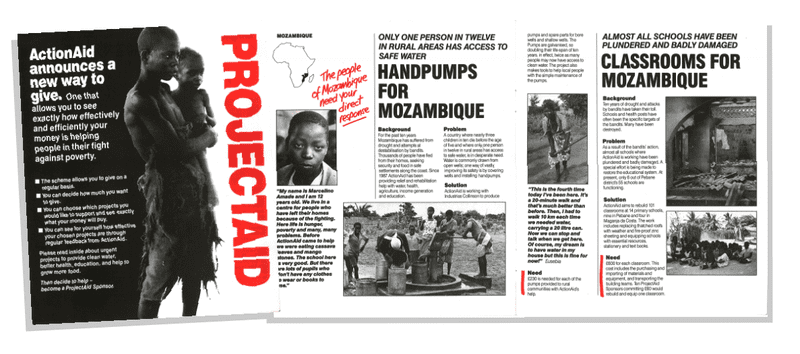
We tested it with a variety of media, but it didn't do that well.
But what was particularly interesting was how donors responded to the offer of choice. Most ended up ticking the 'where the need is greatest' box on the donation form. The product eventually was used as a 'drop ask' for people who were interested in child sponsorship but found the price too high. It was superseded by another product that concentrated on providing good feedback, which in the long run was more effective.
I've been involved in offering choice to donors in a number of different ways over the years and found similar results pretty much every time. Some people do value choice (particularly with causes such as cancer research and with high level gifts), but many others were more interested in hearing about need, impact and what they had done to make a difference. As one donor put it (and I paraphrase)…
"You're the experts on this. I just want to know that my money has helped".
In my experience, that's what charities should be focusing on. As I mentioned in a previous post, choice is only important if it is relevant. If it isn't, it can become a chore and actively turn donors off.
And if you are interested in finding out why, you should probably take a look at this study featured in Neuromarketing on choice fatigue.
If used appropriately, choice can probably enhance your offer, but, using the tried and tested (and tired) golfing analogy, it should be one of a number of clubs in your fundraising bag, rather than a single club that you rely on for the whole game.




